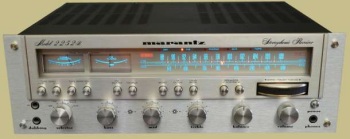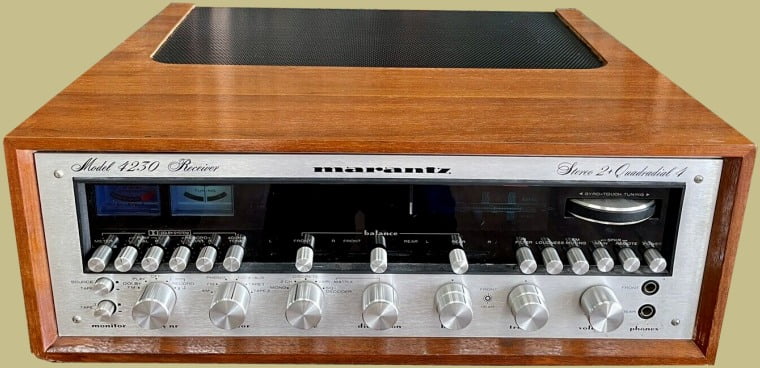
The Marantz 4230 receiver is a 4-channel quadraphonic model that was introduced in 1973 and was on the market until around 1978. It retailed for $499.95 and featured options of a wood cabinet and RC-4 remote control. While it was at the lower end of the Marantz quadraphonic line it still has a plethora of features and controls. The 4220 was the bottom end of the line at 20 watts per channel in stereo and 8 wpc in quadradial mode. Then came the 4230 at 30 wpc in stereo and 12 wpc in quad. These were followed by the 4240 (40 wpc in stereo / 17 wpc in quad) and the 4270 (75 wpc in stereo / 25 in quad). At the higher end were the 4300, at 100 wpc in stereo and 40 wpc in quad, and the top-of-the-line model 4400 which featured 125 wpc in stereo and 50 in quad.

The Marantz 4230 has the classic 1970’s Marantz look though the front panel is a little crowded with controls because of all the 4-channel features. It has both signal strength and tuning meters to the left of the dial face and the iconic gyro tuning wheel to the right. The signal meter will also act as a Dolby calibration meter when the Dolby selector knob is set to anything other than OFF.
There are three slider balance controls, one for Left L/R, one for Rear L/R, and one for Front to Rear. To balance the front channels, first set the Front-Rear control all the way Front to silence the rear channels. Then adjust the Front L/R slider to your favored position. Do the same for the rear channels but adjust the Front-Rear slider all the way to Rear to silence the front channels.
The slider controls can get dirty over the years and cause a number of problems such as weak or erratic volume. A good cleaning of the slider potentiometers can remedy many issues. The lamps on the 4230 tend to fail over time as well. There are a number of lamps, including full kits, available on eBay HERE.

Marantz touted their Vari-Matrix technology in the 4230 which allowed it to simulate 4-channel sound from 2-channel stereo sources. Of course, the 4230 can also utilize 4-channel sources as well as make use of other matrix systems such as SQ (with an optional plugin decoder).
The 4230’s FM tuner section utilizes FET circuitry for the RF amp stage and ceramic filters in the IF tuning circuit and is very sensitive.
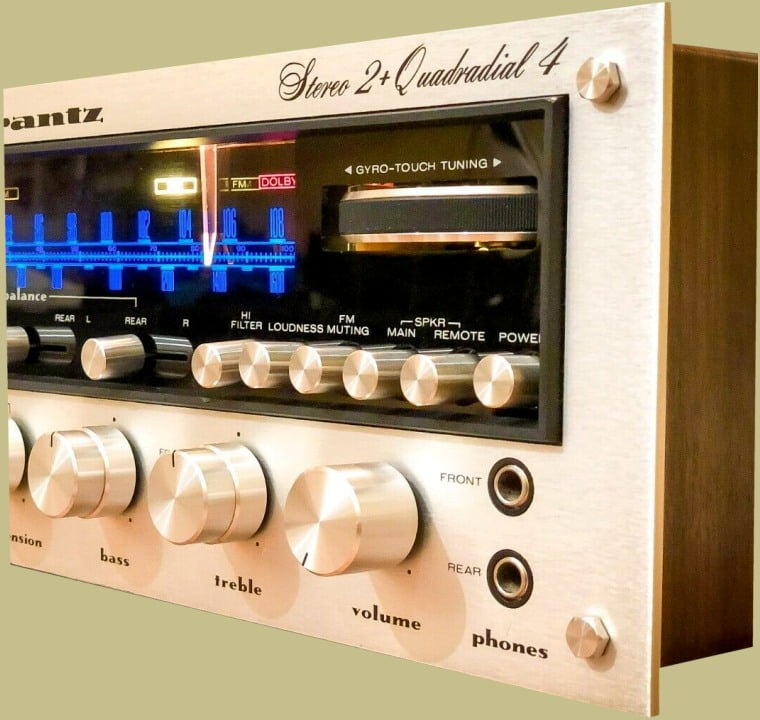
Note that the options on the Mode selector are Mono and 2CH, which are self-explanatory, as well as Discrete and Vari-Matrix. When set to the Discrete selection each input signal goes to its respective output channel. Basically it’s real quadraphonic with each channel going to its own speaker. In Vari-Matrix mode the 4230 takes a 2-channel input and breaks it into 4 channels. The front left and front right will be the same as in Discrete mode but the rear left and right channels are “synthesized” from the front channels. The level of synthetization are controlled by the Dimension knob. You can see a visual representation of this below.
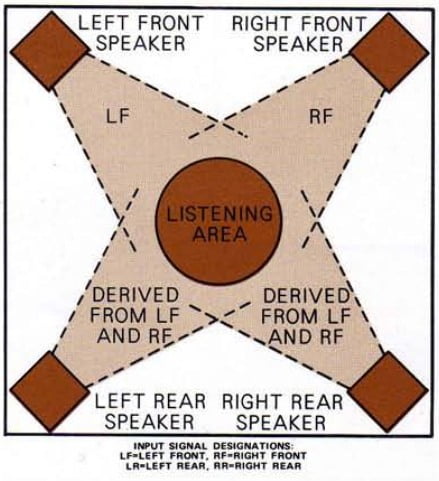
Marantz 4230 buyers had the option to purchase the RC-4 remote control. It retailed for around $40 at the time. It has a 15 foot (5m) cable to allow sufficient movement. Not exactly wireless control but that was as good as it got back then. The RC-4 incorporates 4-channel balance control, a volume control, and a loudness switch. Nope, you can’t change the radio station with the remote. There are usually one or two RC-4 remotes available on eBay.

Here’s an ad for the Marantz 4230 from a 1974 issue of Electronics Today International magazine.
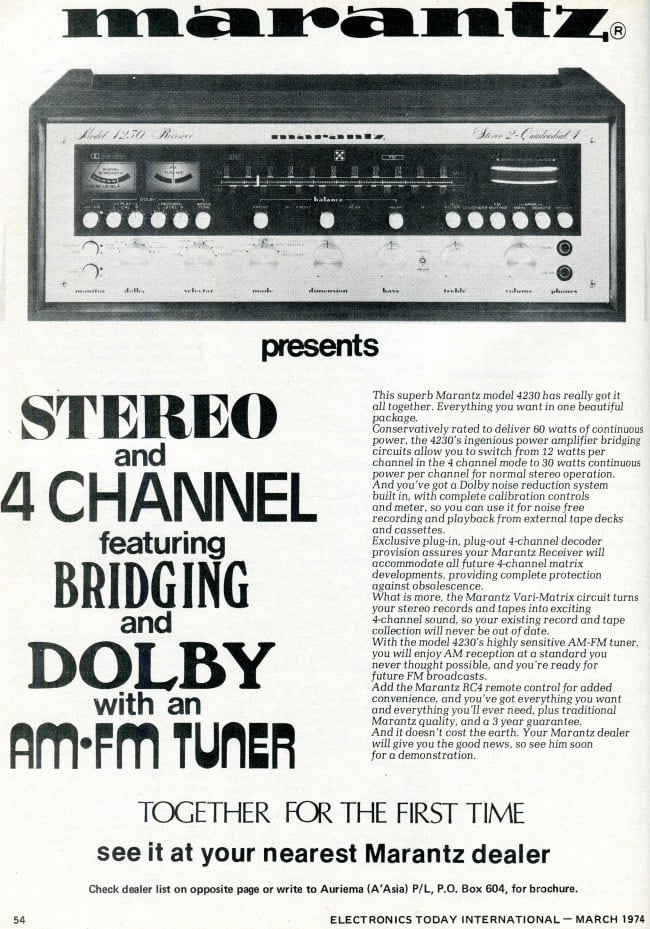
Since the Marantz 4230 is a quadraphonic receiver, or quadradial as Marantz terms it, it has four separate amplifiers – one for each channel. That includes a pre-amp, driver, electronic protective circuits, and output circuits for each of the 4 channels. All this circuitry makes the 4230 a bit crowded inside. It’s not a joy to work on and there are a lot of potential points of failure.
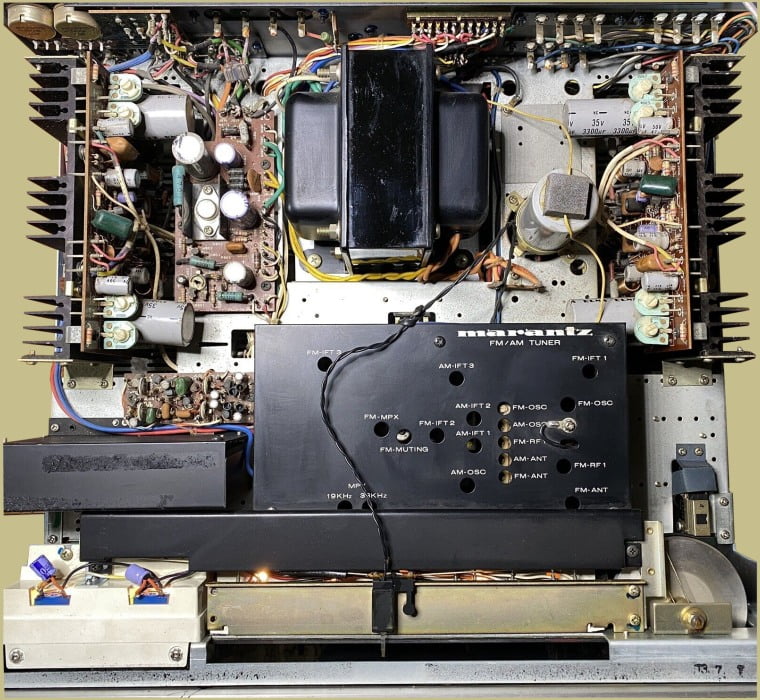
Specifications:
- Tuning range: FM, MW
- Power output: 30W/ch (stereo), 12W/ch into 4Ω (quadraphonic)
- Frequency response: 20Hz to 20kHz
- Total harmonic distortion: 0.9%
- Damping factor: 20
- Input sensitivity: 2.2mV (MM), 150mV (line)
- Dimensions: 17 21/64 x 5 25/64 x 14 3/8 inches (440 x 137 x 365 mm)
- Weight: 31.3 lbs (14.2 kg)
- First Year 1973 – Last Year 1978
- Wood Case WC-122, WC-22
- Channels Four + Two
- Speaker Connections: Two sets
- AC Switch Yes
- Options: RC4 Remote Control, Wood Case, Decoder
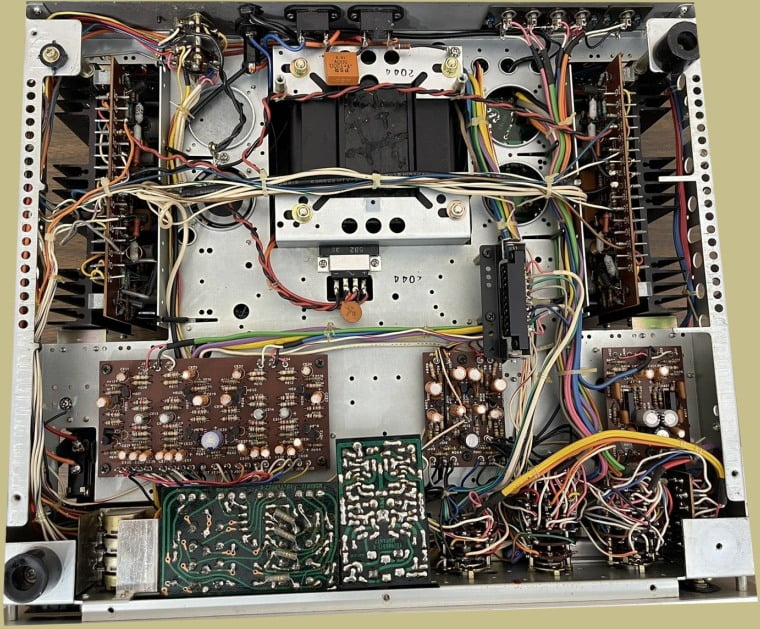
The power mode switch on the back panel is very important. It will switch the 4230 from 4-channel 12 watt output to 2-channel 30 watt output. So, if you’re running 4 speakers in quad mode then that switch needs to be set to the 12W x4 position. For 2 speakers in stereo mode it needs to be set to 30W x2 position. Also, in 2-channel mode only the front speaker terminals are used. ALWAYS TURN OFF the receiver before changing the power mode switch. Don’t switch from 12wpc to 30wpc or vise versa when the receiver is on.

Another thing to remember is not to use 4 ohm speakers in 2-channel mode. They’re OK in 4-channel mode but not 2-channel. Using 4 ohm speakers in 2-channel mode may result in smoke.
The FM Quadradial output on the back panel was designed for 4-channel FM broadcasts of which there aren’t any today so it will not be very useful.

Quadraphonic receivers are not usually my first choice for a vintage stereo. It’s not that they aren’t good but rather they always seem to have issues. Of course, if you have a lot of quadraphonic records or tapes then a 4-channel receiver would make sense. The extra cost of recapping or restoring a quad receiver might be worth it in that case. But, for most vintage enthusiasts a good 2-channel receiver is all that is needed. If you are considering a quad receiver expect to have to sink some money into it unless its already restored.
That being said, the Marantz 4230 is a very good receiver in either 2-channel or quad. It has a great phono section, a sensitive FM tuner, and enough power for a small room or den. It looks great and is very versatile. So, if you’re looking for a quad receiver for a small room then the 4230 may fit the bill.

